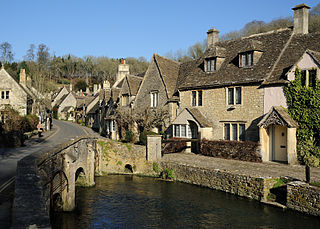
The Cotswolds is a region in central-southwest England, along a range of rolling hills that rise from the meadows of the upper Thames to an escarpment above the Severn Valley and Evesham Vale.

Chipping Campden is a market town in the Cotswold district of Gloucestershire, England. It is notable for its terraced High Street, dating from the 14th century to the 17th century.
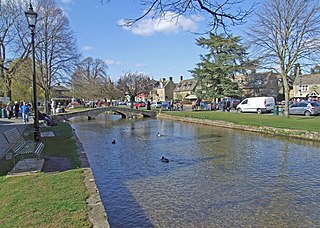
Bourton-on-the-Water is a village and civil parish in Gloucestershire, England, that lies on a wide flat vale within the Cotswolds Area of Outstanding Natural Beauty. The village had a population of 3,296 at the 2011 census. Much of the village centre is a designated Conservation Area.
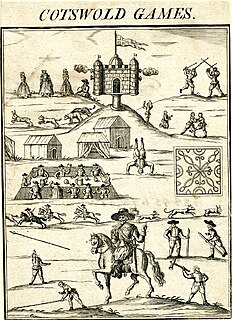
Robert Dover (1575/82–1652) was an English attorney, author and wit, best known as the founder and for many years the director of the Cotswold Olimpick Games.

Horton is a village on the Cotswold Edge, in Gloucestershire, England. It is about 2+1⁄2 miles (4.0 km) north of Chipping Sodbury. The nearest settlement is Little Sodbury, about 1+1⁄2 miles (2.4 km) away; Hawkesbury Upton and Dunkirk are both 2+1⁄2 miles (4.0 km) miles away. It is a linear settlement built on the slopes of a steep hill.

Ampney Crucis is a village and civil parish in the Cotswolds, part of the Cotswold District of Gloucestershire, England.
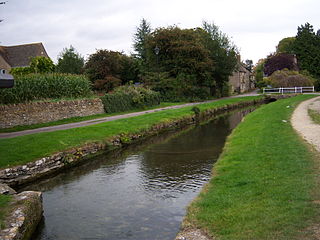
Ashton Keynes is a village and civil parish in north Wiltshire, England which borders with Gloucestershire. The village is about 5 miles (8 km) south of Cirencester and 3.5 miles (5.6 km) west of Cricklade. At the 2011 census the population of the parish, which includes the hamlet of North End, was 1,400.

Aston Subedge is a village and civil parish in the Cotswold district of Gloucestershire, England, close by the border with Worcestershire. According to the 2001 census the population was 55, increasing to 107 at the 2011 census. The village is about 8 miles east of Evesham, and near the village of Weston-sub-Edge.
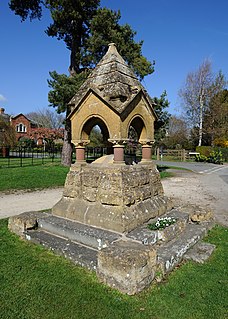
Dumbleton is a village and civil parish in the English county of Gloucestershire. The village is roughly 20 miles from the city of Gloucester. The village is known to have existed in the time of Æthelred I who granted land to Abingdon Abbey, and it is mentioned in the Domesday Book.

Stanton is a village and civil parish in Tewkesbury Borough, Gloucestershire, England. The village is a spring line settlement at the foot of the Cotswold escarpment, about 2+1⁄2 miles (4 km) southwest of Broadway in neighbouring Worcestershire. Broadway is Stanton's postal town. The 2011 Census recorded the parish's population as 198.

Long Marston is a village about 5 miles (8 km) southwest of Stratford-upon-Avon in Warwickshire, England. The southern and western boundaries of the parish form part of the county boundary with Worcestershire. The civil parish is called Marston Sicca. The 2011 Census recorded the parish's population as 436.

Willersey is a village in Gloucestershire, South West England, situated close to the boundary with Worcestershire, West Midlands region and southwest of Evesham. Although situated in Gloucestershire, the postal county for the village is Worcestershire, due to it being covered by the Broadway post town. It is an old village with much character. There are two pubs in the village - The Bell Inn and The New Inn. There is a primary school and as well as a large park area. The duck pond is much admired by visitors to the village.
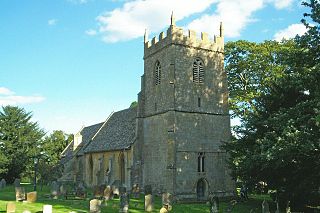
Ebrington is a village and civil parish in Gloucestershire, England, about 2 miles (3.2 km) from Chipping Campden. It has narrow lanes and tiny streets of Cotswold stone houses and cottages, many of which are thatched.

Campden was, from 1894 to 1935, a rural district in the administrative county of Gloucestershire, England. The district lay on the north-eastern boundary of Gloucestershire, and consisted of three separate areas nearly surrounded by the counties of Warwickshire and Worcestershire. The county and district boundaries were simplified in 1931 and the district was abolished in 1935.

Pebworth was, from 1894 to 1931, a rural district in the administrative county of Gloucestershire, England. The district consisted of four parts, divided from each other by a section of Worcestershire.

Elkstone is a village and civil parish in the English county of Gloucestershire. In the 2001 United Kingdom census, the parish had a population of 203, increasing to 248 at the 2011 census

North Cerney is a village and civil parish in the English county of Gloucestershire, and lies within the Cotswolds, a range of hills designated an Area of Outstanding Natural Beauty. The village is 4 miles (6.4 km) north of Cirencester within the Churn valley. It was recorded as Cernei in the Domesday Book. However, the North Cerney parish boundaries were known to exist in 852 AD when it was recorded that King of the Mercians granted lands in North Cerney to a man called Alfeah.

Saintbury is a village and civil parish in the Cotswold District of Gloucestershire, England. The population of the civil parish at the 2011 Census was 83. Saintbury was mentioned in the Domesday Book (1086) as Suineberie.

Hailes is a small village in Gloucestershire, England, 2 miles (3.2 km) north-east of Winchcombe. The village lies at the foot of the Cotswold escarpment. The remains of Hailes Abbey, a Cistercian abbey active from 1246 to 1539, are here.

The Anglican Church of St Nicholas at Saintbury in the Cotswold District of Gloucestershire, England was built in the 13th century. It is a grade I listed building.




















